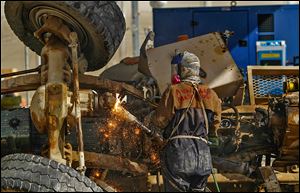
U.S. military leaving $7B in scrap before exit from Afghanistan
10/20/2013
An armored vehicle is 'decommissioned' in a scrap yard at Bagram Airfield in Afghanistan. It is being cut up into scrap. The U.S. military is leaving billions in equipment behind, but first removing components that could be used by militants.
BAGRAM, Afghanistan — The armored trucks, televisions, ice cream scoops, and nearly everything else shipped to Afghanistan for the war against the Taliban are now part of the world’s biggest garage sale.
Every week, as the U.S. troop drawdown accelerates, the United States is selling 12 million to 14 million pounds of its equipment on the Afghan market.
Returning that gear to the United States from halfway around the world would be prohibitively expensive, according to U.S. officials.
Instead, they’re leaving behind $7 billion worth of supplies, a would-be boon to the fragile Afghan economy.
But there’s one catch: The equipment is being destroyed before it’s offered to the Afghan people — to ensure that treadmills, air conditioning units, and other rudimentary appliances aren’t used to make roadside bombs.
“Many nonmilitary items have timing equipment or other components in them that can pose a threat. For example, timers can be attached to explosives. Treadmills, stationary bikes, many household appliances and devices, et cetera, have timers,” said Michelle McCaskill, a spokesman for the Pentagon’s Defense Logistics Agency.
That policy has produced more scrap metal than Afghanistan has ever seen.
It also has led to frustration among Afghans, who feel as if they’re being robbed of items like flat-panel televisions and armored vehicles that they could use or sell — no small thing in a country where the average annual income hovers at just over $500.
In a nation nicknamed the “graveyard of empires,” foreign forces are remembered for what they leave behind.
In the 1840s, the British left forts that still stand today. In the 1980s, the Russians left tanks, trucks, and aircraft strewn about the country.
The United States is leaving heaps of mattresses, barbed wire, and shipping containers in scrap yards near its shrinking bases.
“This is America’s dustbin,” said Sufi Khan, a trader standing in the middle of an immense scrap yard outside Bagram Airfield, the U.S. military’s sprawling headquarters for eastern Afghanistan.
The scrap yard looks like a post-industrial landfill in the middle of the Afghan desert, a surreal outcropping of mangled metal and plastic.
There’s a tower of treadmills 50 feet high and an acre of buses, trucks, and vans. An ambulance is perched atop a pile of scrap, as if it fell from the sky. A mountain of air conditioners sits next to a mountain of truck axles.
Some of the scrap shows signs of its previous owners — vehicles spray-painted with American names, mattresses sunken from 12 years of use, bumper stickers from Oklahoma.
The Bagram scrap yard is owned by Feda Mohammad Ulfat, who helped build the neighboring base more than a decade ago, transporting gravel and concrete.
Now Mr. Ulfat is helping to dismantle the base, taking in thousands of pounds of American scrap metal every day.
“I never imagined we’d be getting this much stuff,” he said.
Not all of the equipment reaching the scrap yard was deliberately damaged: Some was already broken after a decade of use. Mr. Ulfat decided several years ago that he would invest in it anyway.
Some of his friends thought he was crazy, but Mr. Ulfat had an idea: The expensive American gear could be melted and reconstituted as raw material for an Afghan building boom. He’d gotten rich on dozens of other contracts with the U.S. military, and he assumed this would be no different.
When he first signed the contract, the scrap metal was only trickling in.
But over the past six months, America’s drawdown has reached a fever pitch in eastern Afghanistan, with dozens of bases being closed.
Suddenly a torrent of scrap metal was delivered to Mr. Ulfat’s farm. He had to buy more land. Scrap was piled atop scrap. He now spends up to a half-million dollars a month on gear that has been shredded or flattened.
When U.S. officials first began planning for their exit, the idea was to ship home the majority of their equipment, especially expensive military gear like mine-resistant vehicles.
That calculus has changed.
The Pentagon has budgeted $5 billion to $7 billion to ship gear back to the United States. But that sum isn’t enough to take everything currently in Afghanistan.
Wanting at least a small return on their investment, the U.S. military decided to sell the leftovers for pennies on the pound.
That’s where Mr. Ulfat came in. He has now opened his scrap yard to the public.
Small groups of men wander around, buying broken air conditioners that can be stripped of their copper wiring or sheets of corrugated iron that can be sold to Pakistani traders.